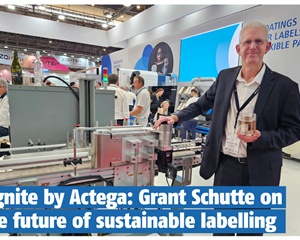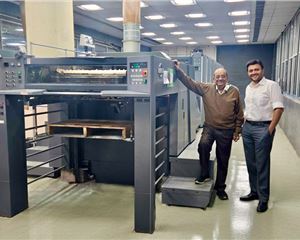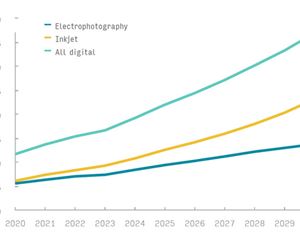Colour beyond CMYK charts a global supply chain path
J Natasha, director at Veepee Graphic Solutions, explains how extended colour gamut delivers precision, speed and sustainability for Indian label converters’ consistency.
19 Sep 2025 | By Noel D'Cunha
When J Natasha, director at Veepee Graphic Solutions, launched her own nail polish line as a teenager, she deliberately curated shades based on the CMYK+OGV (cyan, magenta, yellow and black + orange, green and violet) palette. The limited-edition set symbolised her fascination with colour, but it also reflected a conviction that packaging and consumer products could speak the same visual language. Years later, as director at Veepee Graphic Solutions, she makes the case that extended colour gamut is no longer an experiment but a requirement for the print and packaging sector.
She opens the discussion with urgency. “Seven colours, no limits. Extended colour gamut (ECG) is not the future, it is the takeover,” she says. Her message is clear. CMYK has been the backbone of modern printing for decades, yet it cannot meet the demands of today’s brands for vibrancy, accuracy and speed. To her, ECG represents not just an upgrade in ink sets but a wholesale transformation of how print shops deliver colour.
ECG builds on the four-colour CMYK base by adding orange, green and violet. This shift creates a seven-colour system capable of reproducing tones that fall outside the reach of CMYK. By expanding the gamut, printers can hit a wider spectrum of brand colours without the need for custom spot inks.
Natasha positions ECG as essential for converters working in sectors such as FMCG, cosmetics, pharmaceuticals and flexible packaging. She explains, “For brands with global consistency goals, ECG is the practical route to achieving colour harmony across regions and substrates.”
She illustrates the difference visually. CMYK appears limited when overlaid against Pantone, but ECG pushes the gamut closer to the full universe of colours that designers and brand managers specify. The triangle of overlap demonstrates that ECG delivers far more vibrancy and coverage than CMYK alone.
Her framing is not merely technical. By describing ECG as the connection between quality and cost efficiency, she makes it clear that the shift has implications for profit margins as much as aesthetics. It is a tool for growth, not just a palette for creativity.
For Indian converters, she argues, this is an inflection point. The choice is no longer between tradition and innovation. The market is moving, and printers must move with it.
Print consistency, every time
Colour consistency has long been one of the toughest demands in packaging. Variations in substrates, press conditions and operator skill often translate into inconsistent print runs. Natasha explains that ECG is designed to eliminate this uncertainty. “It is a sniper in colour precision,” she says, underlining how the fixed seven-colour set guarantees stable output.
Unlike CMYK workflows that rely on swapping inks and constant recalibration, ECG maintains a delta E of less than two. This level of precision ensures that colours remain uniform regardless of where or when the job is printed. It means that a cosmetic package produced in Bengaluru will look identical to one produced in Colombo.
She likens the difference to a performance shift. CMYK presses are prone to drift, trial and error, and human error in spot colour matching. With ECG, calibration is performed once and maintained. “It is like turning your press into a race car,” she says, describing a system built for speed and control rather than guesswork.
For converters, the impact is direct. Print jobs no longer carry the risk of brand colours veering off target. Instead, each run reproduces the approved shades with near-perfect accuracy. For multinational brands that monitor packaging consistency closely, this reliability becomes a competitive differentiator.
Natasha highlights that ECG consistency is not about making colours prettier but about transforming them into a controlled process that can be scaled across regions and substrates. She views it as a strategic advantage, enabling printers to meet demanding brand standards while maintaining efficient operations.
The conversation shifts from the aesthetic to the practical. Consistency reduces disputes, re-runs and material waste. It reassures clients that they can trust converters to deliver results that align with brand expectations every time.
Ultimately, Natasha frames consistency as the bedrock of scale. “Without it, global growth is impossible. With it, Indian converters can compete on equal terms with the best in the world.”
Pantone accuracy, no spots
Pantone has long been the benchmark for brand managers. The challenge for converters has been matching these colours without resorting to special spot inks. Natasha explains that ECG solves this problem by expanding coverage to approximately 90% of the Pantone library.
She overlays CMYK, ECG and Pantone in a diagram to show how closely the seven-colour process aligns with the full Pantone universe. “This is what ECG does. It builds the bridge,” she says, positioning the technology as a solution to an old industry dilemma.
For printers, this eliminates the need to mix and store dozens of custom inks. It also reduces the frequent wash-ups that slow down production. For brand owners, it means packaging can meet exact specifications without delays or compromises.
Natasha frames Pantone accuracy as both a technical and strategic achievement. With ECG, converters can guarantee results without the operational complexity of managing spot colours. This allows them to service clients faster, reduce downtime and cut costs.
She stresses that this is not only about visual appeal. It is about scale. Brands no longer need to worry that a shade will vary across geographies or that custom inks will increase costs. With ECG, the process is standardised and repeatable. By simplifying colour management, converters unlock new levels of efficiency. They also position themselves as partners capable of meeting global brand demands, something that is increasingly expected in export-driven packaging markets.
For Indian printers, Pantone accuracy without spot inks is not simply a technical feat. It is a passport to global competitiveness.
Faster changeovers, less waste
One of the biggest operational bottlenecks in traditional CMYK printing is the time required for ink changes and wash-ups (between 30 and 45 minutes depending on the efficiency of the operator). Natasha contrasts this with ECG, which uses a fixed seven-colour ink set. “No ink swaps, no trial and error, just profile load and print,” she explains.
This simplicity translates into faster job changeovers and reduced downtime (25 to 30% increase in productivity). With fewer plate changes, converters can run more jobs in a given timeframe. The reduced reliance on operator intervention also lowers the risk of errors.
For converters managing multiple SKUs or short runs, the benefit is immediate. Jobs can be switched with minimal disruption, enabling presses to handle a wider range of work without losing efficiency.
Natasha notes that reduced wash-ups mean not only time savings but also lower consumption of cleaning materials (any estimation on this?). This further reduces cost and waste, creating efficiencies that flow through the entire operation.
The comparison with CMYK is stark. Traditional workflows involve constant ink management, long make-ready times and high labour intensity. EECG streamlines the process into a standardised system that accelerates output while improving consistency. By improving throughput, converters can meet tighter deadlines and respond more quickly to client demands. This positions them to capture opportunities in fast-moving markets such as FMCG.
She summarises the shift as moving from a stop-start model of production to a continuous flow of work. Efficiency is no longer a bonus but an expectation.
Sustainable, smart operations
Sustainability is no longer optional in packaging. Natasha argues that ECG delivers environmental benefits alongside efficiency gains. “Print smarter, waste less and look better while doing it. That is the power of ECG,” she says.
She points to reduced ink consumption as a direct result of the fixed seven-colour set. With fewer wash-ups, printers use less water and fewer solvents. Shorter make-ready times mean presses consume less energy, and fewer plate changes reduce material usage.
Compared with CMYK workflows, which often involve high water usage, volatile organic compound emissions and excess waste, ECG offers a cleaner alternative. By standardising the ink set, converters can achieve sustainability without sacrificing quality or profitability.
Natasha stresses that sustainability is not a bonus but a requirement in today’s market. Brands are under pressure to reduce its environmental footprint, and converters must align with these expectations. ECG, she argues, provides a path to do so while improving margins.
For Indian converters, sustainability is also a business imperative. Regulations are tightening, and clients increasingly demand proof of reduced environmental impact. ECG positions printers to meet these requirements without compromising on performance. The ecological gains are matched by operational benefits. Reduced waste and emissions translate into lower costs, reinforcing the business case for adoption.
By aligning sustainability with profitability, ECG strengthens the strategic position of converters in a global marketplace that prioritises responsibility alongside efficiency.
Scalable colour, global impact
Natasha concludes by emphasising scalability. Once a press is calibrated for ECG, the workflow becomes repeatable across jobs, plants and geographies. This ensures that brand colours remain consistent regardless of location.
For multinational companies, this is crucial. Packaging must look identical whether produced in India, Europe or Southeast Asia. ECG makes this possible, allowing Indian converters to deliver results that match global expectations.
Natasha connects this back to the history of Veepee Graphic Solutions, founded by her grandfather in 1961 as a small design studio. From hand-done colour separations to digital precision, the company has grown into a premier trade shop. Today, led by her father, P Jaichandra and mother Nalani Jaichandra, with operations in Bengaluru, Pune, Hyderabad, New Delhi, and Colombo, the company now serves converters across the subcontinent and beyond.
By adopting innovations such as ECG, Natasha argues, Veepee and other Indian converters are not only keeping pace with international trends but shaping the future of the industry.
She frames ECG as a system for empowerment. It gives converters the ability to deliver precision, speed and sustainability while competing at a global level. “ECG consistently comes out ahead,” she notes, before closing with a sharper emphasis.
“ECG wins every time,” she says, summing up her conviction that the seven-colour process is the new standard for print.
Her story of starting Nash Cosmetics as a teenager underscores her long-standing passion for colour. That passion now drives her advocacy for ECG as a transformative force for the industry.
The implication is clear. For Indian label converters, the move to ECG is not just about meeting client demands. It is about claiming a place in the global supply chain of the future.












 See All
See All